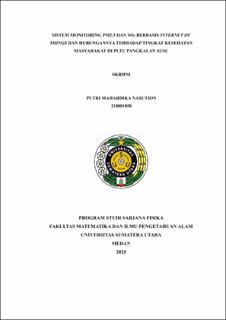| dc.description.abstract | Coal-fired power plants are significant contributors to air pollution, primarily through the emission of Particulate Matter (PM2.5) and sulfur dioxide (SO2) from fossil fuel combustion. The designed system utilizes sensors connected to an IoT-based microcontroller, capable of transmitting data via Wi-Fi to a cloud server and displaying it automatically on a Blynk dashboard. Testing and calibration results confirmed the device's stable operation with adequate accuracy. PM2.5 and SO2 concentrations were measured for 4 weeks in two distinct locations: Tanjung Pasir Village, situated near a Coal-Fired Power Plant (PLTU), and Lubuk Kasih Village, located far from the PLTU. Additionally, a structured questionnaire survey was conducted to collect public health data, including demographic information, perceptions of air quality, and respiratory symptoms, which were then correlated with pollution levels. Analysis revealed a significant positive correlation between PM2.5 and SO2 concentrations in Tanjung Pasir Village, indicating common emission sources or environmental conditions supporting the co-accumulation of both pollutants, as well as a higher potential health risk. The Pearson correlation coefficient is 0.899. This value indicates a very strong positive relationship between pollutants and public health. Conversely, in Lubuk Kasih Village, the correlation tended to be weak, and detected diseases were not directly linked to PM2.5 and SO2 pollution. The Pearson correlation coefficient obtained is -0.259. This value indicates a weak negative relationship between pollutants and public health. This study successfully achieved its objective of producing a practical air pollution monitoring system that supports air quality trend analysis and health impact evaluation. | en_US |


